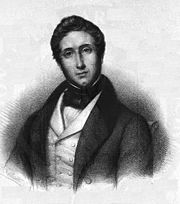
Jean Zuléma Amussat
Encyclopedia

France
The French Republic , The French Republic , The French Republic , (commonly known as France , is a unitary semi-presidential republic in Western Europe with several overseas territories and islands located on other continents and in the Indian, Pacific, and Atlantic oceans. Metropolitan France...
surgeon
Surgery
Surgery is an ancient medical specialty that uses operative manual and instrumental techniques on a patient to investigate and/or treat a pathological condition such as disease or injury, or to help improve bodily function or appearance.An act of performing surgery may be called a surgical...
.
Amussat was born in Saint-Maixent
Saint-Maixent
Saint-Maixent is a commune in the Sarthe department in the region of Pays-de-la-Loire in north-western France.-References:*...
, Deux-Sèvres
Deux-Sèvres
Deux-Sèvres is a French département. Deux-Sèvres literally means "two Sèvres": the Sèvre Nantaise and the Sèvre Niortaise are two rivers which have their sources in the department.-History:...
. He became a renowned physician whose primary contributions were in the field of genitourinary surgery. Most of his work was through a private practice he held in Paris
Paris
Paris is the capital and largest city in France, situated on the river Seine, in northern France, at the heart of the Île-de-France region...
. He is remembered for the eponymous Amussat's method or "torsion
Torsion
The word torsion may refer to the following:*In geometry:** Torsion of a curve** Torsion tensor in differential geometry** The closely related concepts of Reidemeister torsion and analytic torsion ** Whitehead torsion*In algebra:** Torsion ** Tor functor* In medicine:** Ovarian...
of the arteries
Artery
Arteries are blood vessels that carry blood away from the heart. This blood is normally oxygenated, exceptions made for the pulmonary and umbilical arteries....
", which is a procedure used to arrest arterial hemorrhaging. He was also an early practitioner of lithotripsy
Lithotripsy
Lithotripsy refers to the physical destruction of gallstones or kidney stones. The term is derived from the Greek words meaning "breaking stones" .Forms include:* Extracorporeal shock wave lithotripsy...
, which was a "minimally invasive" surgery to crush stones inside the bladder
Urinary bladder
The urinary bladder is the organ that collects urine excreted by the kidneys before disposal by urination. A hollow muscular, and distensible organ, the bladder sits on the pelvic floor...
via the urethra
Urethra
In anatomy, the urethra is a tube that connects the urinary bladder to the genitals for the removal of fluids out of the body. In males, the urethra travels through the penis, and carries semen as well as urine...
. This operation necessitated use of an instrument called the lithotrite
Lithotrite
The lithotrite was an early medical device, invented by Jean Civiale, which was used to perform transurethral lithotripsy, the first known minimally invasive surgery, to crush stones inside the bladder without having to open the abdomen . To remove a calculus the instrument was inserted through...
, which had been recently invented by Jean Civiale
Jean Civiale
Jean Civiale was a French surgeon and urologist, who, in 1832, invented a surgical instrument and performed transurethral lithotripsy, the first known minimally invasive surgery, to crush stones inside the bladder without having to open the abdomen...
(1792–1867).
Amussat has several eponyms related to him:
- Amussat's fold: abnormal folds of the membranous urethraMembranous urethraThe intermediate part of male urethra is the shortest, least dilatable, and, with the exception of the external orifice, the narrowest part of the canal....
at the level of the seminal colliculusSeminal colliculusThe seminal colliculus , or verumontanum, of the prostatic urethra is a landmark near the entrance of the seminal vesicles. Verumontanum is translated from Latin to mean 'mountain ridge', a reference to the distinctive median elevation of urothelium that characterizes the landmark on magnified...
. - Amussat's method: torsion of the arteries to prevent arterial hemorrhaging.
- Amussat's operation: extraperitoneal colostomyColostomyA colostomy is a surgical procedure in which a stoma is formed by drawing the healthy end of the large intestine or colon through an incision in the anterior abdominal wall and suturing it into place. This opening, in conjunction with the attached stoma appliance, provides an alternative channel...
in the lumbarLumbarIn tetrapod anatomy, lumbar is an adjective that means of or pertaining to the abdominal segment of the torso, between the diaphragm and the sacrum ...
region for obstruction of the colonColon (anatomy)The colon is the last part of the digestive system in most vertebrates; it extracts water and salt from solid wastes before they are eliminated from the body, and is the site in which flora-aided fermentation of unabsorbed material occurs. Unlike the small intestine, the colon does not play a...
. - Amussat's valves: Spiral valves within in the cystic ductCystic ductThe cystic duct is the short duct that joins the gall bladder to the common bile duct. It usually lies next to the cystic artery. It is of variable length...
. The cystic duct is the anatomical structure that joins the gall bladder to the common bile ductCommon bile ductThe common bile duct is a tube-like anatomic structure in the human gastrointestinal tract. It is formed by the union of the common hepatic duct and the cystic duct . It is later joined by the pancreatic duct to form the ampulla of Vater...
.
Partial bibliography
- On lithotripsy.
- On the use of animal experiments in physiology.
- Amussat’s lessons on retention of urine, caused by strictures of the urethra, and on the diseases of the urethra. Edited by A. Petit. Translated from the French by James P. Jervey, M. D. 3 p. 1., 246 pages. Charleston, S. C. J. Dowling, 1836
External links
- Jean Zuléma Amussat at Who Named ItWho Named ItWho Named It? is an English-language dictionary of medical eponyms and the people associated with their identification. Though this is a dictionary, many eponyms and persons are presented in extensive articles with comprehensive bibliographies. It is hosted in Norway and maintained by medical...
- Collection of Medical Antique Instruments

